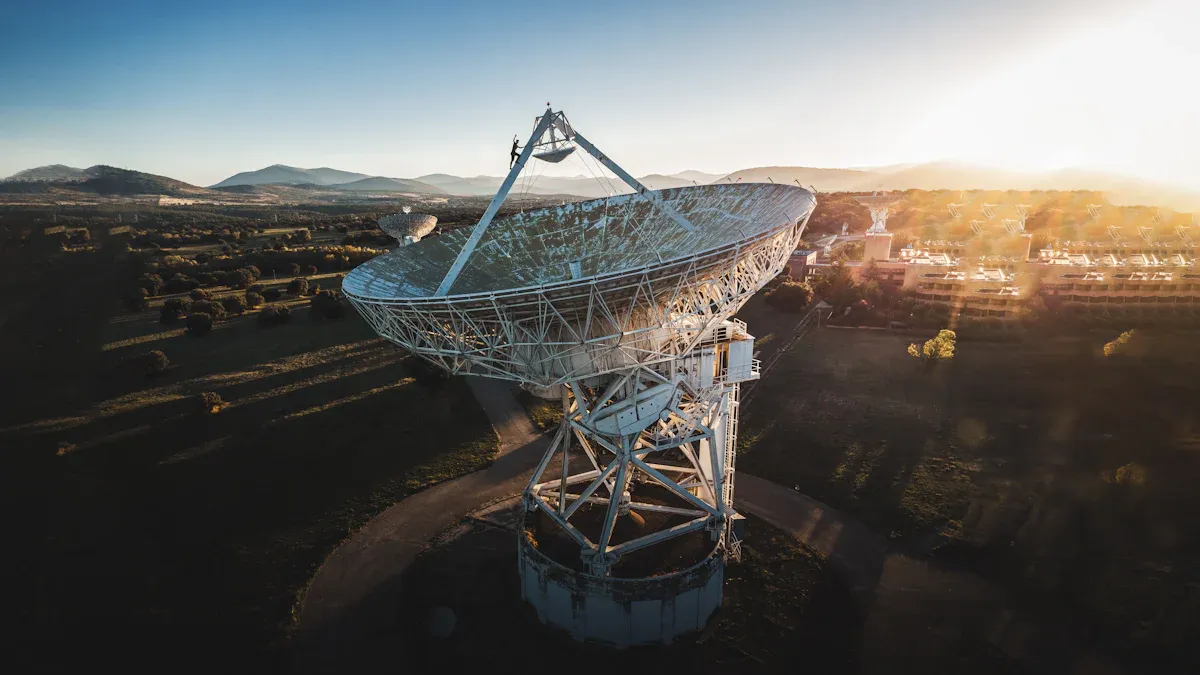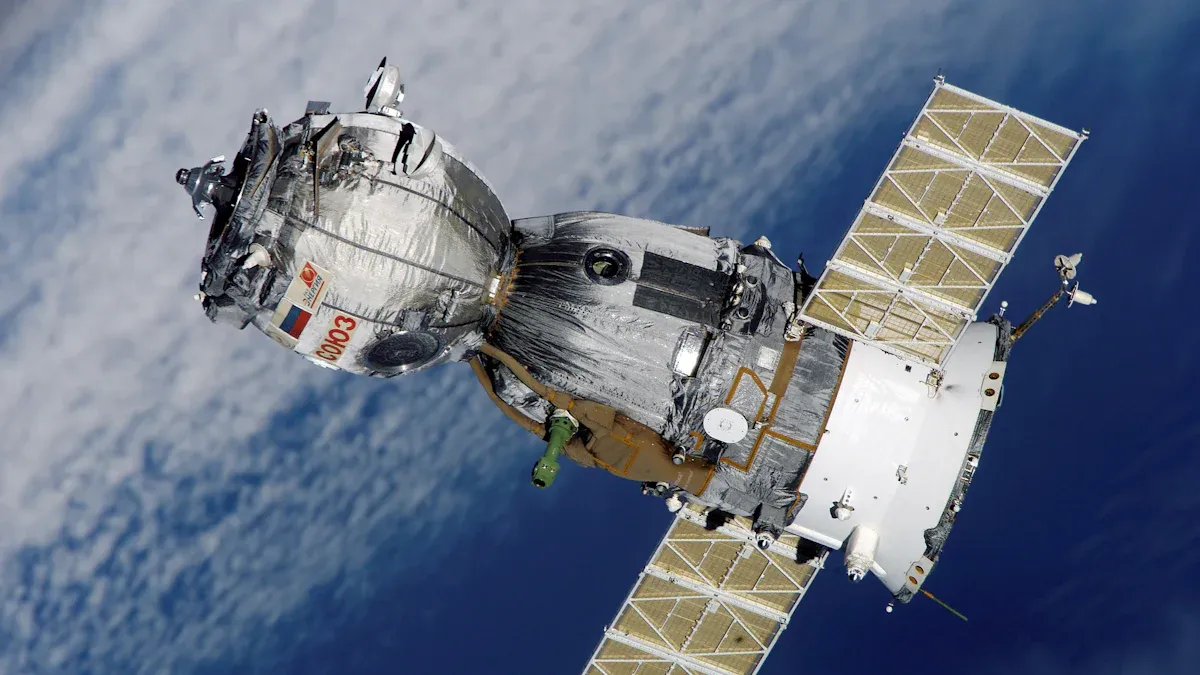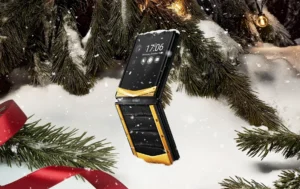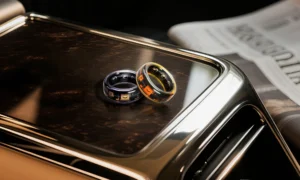
You use a satellite communication smartphone when there is no cell service. This technology lets your phone work like a satellite phone. You can send messages or call for help in faraway places. A satellite phone connects straight to a satellite in space, not a cell tower. Some new phones, like the VERTU QUANTUM FLIP, have this feature. You use satellite communication on your phone for safety and to feel calm. When you hold a satellite phone, you have satellite communication in your hand.
Key Takeaways
-
Satellite communication on smartphones lets you send messages or call for help when there is no cell service.
-
These phones connect straight to satellites in space, not to cell towers. This gives you coverage in faraway places like mountains, oceans, and deserts.
-
You need a special phone with satellite features. You also need a clear view of the sky. Sometimes you need a subscription plan to use satellite communication.
-
Satellite features work best outside. They are helpful during emergencies, outdoor trips, and when cell networks do not work.
-
More smartphones will have satellite communication in the future. This will make it easier to stay connected anywhere on Earth.
Satellite Communication Smartphone Basics

What It Means for Smartphones
When you use a satellite communication smartphone, you can stay connected in new ways. This kind of phone lets you send messages or call for help when there is no cell signal. You do not have to look for a cell tower. Your phone connects right to a satellite far above Earth. This helps you stay safe in places where normal phones do not work.
Satellite connectivity lets you reach out from high mountains, the ocean, or deserts. You do not need to worry about losing contact if you travel far from cities. Many people use this for adventure, work, or emergencies. With a satellite communication smartphone, you can feel safe and sure wherever you are.
Tip: Always check if your phone can use satellite connectivity before you go to faraway places.
Key Differences from Cellular Networks
You may wonder how satellite communication is different from regular cell networks. The biggest difference is how your phone connects. A normal smartphone uses cell towers on the ground. These towers send signals to your phone. If you go too far, you lose service.
A satellite communication smartphone does not need these towers. It has a special antenna that sends signals to a satellite in space. The satellite sends your message to a ground station, which gives it to the right person. This way, you get coverage almost everywhere, not just in some places.
Here is a quick comparison:
|
Feature |
Cellular Network |
Satellite Connectivity |
|---|---|---|
|
Coverage Area |
Local/Regional |
Global (almost anywhere) |
|
Needs Cell Towers |
Yes |
No |
|
Works in Remote Areas |
No |
Yes |
|
Main Use |
Everyday Communication |
Emergency/Remote Use |
Satellite connectivity helps you talk to others when nothing else works. You can count on this technology for important messages in hard times.
Satellite Connectivity Explained

How Smartphones Connect to Satellites
You may wonder how your smartphone talks to a satellite. Your phone has special hardware inside. Some new smartphones have advanced antennas and chipsets. These parts help your phone send signals to satellites. You do not need to be near a cell tower.
Smartphones use L band radio frequencies for this. The L band works with most new phones. It helps with satellite messaging and emergency services. When you send a message, your phone’s antenna sends a signal up to a satellite. The satellite sends your message down to a ground station. Then the message goes to the person you want to reach.
Special antennas make this work. Here is how they help your phone connect to satellites:
-
Special antennas in smartphones use satellite wireless spectrum with unique chipsets and radios.
-
These antennas let your phone use direct-to-device (D2D) technology, so it connects to satellites without a cell tower.
-
The antennas and chipsets send and receive signals, even with interference.
-
Because smartphone antennas are small, they focus on basic satellite features like emergency texts or short calls.
-
The design balances size, power, and performance, so you get good communication in far places.
Note: The VERTU QUANTUM FLIP uses this technology. It lets you send satellite messages almost anywhere.
When Satellite Features Are Used
You use satellite connectivity when you cannot reach a cell tower. This happens in remote places like mountains, deserts, or at sea. If you go where there is no cell service, your phone’s satellite features keep you connected. You can send emergency messages or ask for help, even far from cities.
Satellite connectivity is also important during disasters. Sometimes storms or earthquakes break cell towers. In these times, your phone can switch to satellite mode. This makes sure you have a way to talk to others in an emergency.
Here are some times when you might use satellite connectivity:
-
Hiking or camping in the wild
-
Sailing or traveling by boat
-
Exploring deserts or cold places
-
Working in faraway job sites
-
Facing emergencies when cell networks are down
A table shows when satellite features are needed:
|
Situation |
Satellite Connectivity Needed? |
|---|---|
|
City or town |
No |
|
Mountain hiking |
Yes |
|
Ocean travel |
Yes |
|
After a big storm |
Yes |
|
Everyday errands |
No |
Satellite connectivity helps you feel safe. You know you can get help or send a message, even in hard-to-reach places. This technology keeps you connected when you need it most.
Using Satellite Features
Step-by-Step Guide
You can use your smartphone as a satellite phone in far places. This guide shows you how to get started:
-
Check Your Device
Make sure your phone can use satellite features. Phones like the VERTU QUANTUM FLIP have this built in. -
Go Outside
Go to a place with nothing blocking the sky. Your phone needs a clear sky to connect to a satellite. -
Enable Satellite Services
Open your phone’s settings. Find the option for satellite services. Some phones have a special button or app for this. -
Start Messaging or SOS
Pick satellite messaging or emergency help. Type your message or use the SOS if you need help fast. -
Wait for Connection
Hold your phone still. It will connect to a satellite and send your message. You might see a bar or a check mark.
Tip: Charge your phone before you leave home. This helps you call for help if you need it.
Requirements and Limitations
Not all phones can work as a satellite phone. You need a phone like the VERTU QUANTUM FLIP. Here are some things to remember:
|
Requirement |
Details |
|---|---|
|
Compatible Device |
Only some smartphones have this feature |
|
Clear View of the Sky |
Trees or buildings can block the signal |
|
Subscription or Plan |
Some services need a paid plan |
|
Battery Life |
Satellite features use more battery |
You cannot use a satellite phone inside or underground. Go outside for the best signal. Some emergency features only work in certain places. Always read your phone’s manual before you travel.
Supported Smartphones and Real-World Use
Compatible Devices
Only a few smartphones have satellite features right now. The VERTU QUANTUM FLIP is a fancy phone with global satellite messaging. It uses new technology and strong parts, so it is good for people who want style and good use. Some other brands have satellite features too. Apple put satellite messaging in some iPhones. Samsung is making phones with this technology as well. Most normal phones do not have satellite features yet. You should check your phone before you go to faraway places.
Note: Always check your phone maker’s website to see if your phone can use satellite messaging.
Emergency and Remote Use Cases
You use satellite features when you need help but cannot reach a cell tower. Many people use these features to stay safe outside. If you hike in the mountains or sail on the ocean, your phone can send a message by satellite. This lets you reach emergency help even far from cities. People working in faraway places use satellite messaging to talk to their teams. When disasters break cell towers, satellite connections help you get help.
Here are some real-world uses: – Sending an SOS message while hiking – Contacting emergency services after a storm – Staying in touch while in deserts or at sea
Current Limitations
There are some limits to satellite features. Most smartphones need a clear sky to use satellite messaging. Trees, buildings, or bad weather can block the signal. You might need a special plan or pay money to use these services. Satellite messaging usually only lets you send texts or short calls, not full internet. Always read your phone’s manual and try the feature before you depend on it in an emergency.
Satellite communication on smartphones helps you stay in touch far away. You can send messages or call for help if there is an emergency. But you need a clear sky and a special phone for this to work. In the next ten years, more phones will get this feature as technology gets better.
|
Year |
Projected Market Size / Event |
Key Details |
|---|---|---|
|
2025 |
Satellite services and equipment are included |
|
|
2030 |
Over $300B |
New satellites and 5G will help the market grow |
|
2035 |
Over $500B |
Satellite features will be used all over the world |
-
Governments are spending money to build better satellite networks.
-
Smaller and lighter devices make using satellite features easier.
Soon, more smartphones will have satellite communication.
FAQ
How do you know if your smartphone supports satellite communication?
Check your phone’s settings or manual to find out. Look for words like “satellite” or “emergency SOS.” You can also check your phone maker’s website. Phones such as the VERTU QUANTUM FLIP have satellite messaging listed as a feature.
Do you need a special plan to use satellite messaging?
Most satellite messaging needs a subscription or special plan. Some phones give free emergency SOS for a short time. Always check your provider’s rules before you travel.
Can you use satellite features indoors?
No, you must see the sky for it to work. Buildings, trees, or mountains can block the signal. Go outside and hold your phone up for the best signal.
What can you do with satellite communication on your phone?
You can send emergency messages or share your location. You can contact help when there is no cell service. Some phones let you send short texts. You cannot use the internet or watch videos.
Tip: Try your satellite feature before your trip. This helps you learn how it works.







